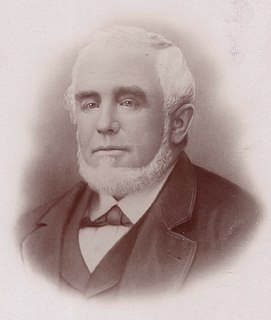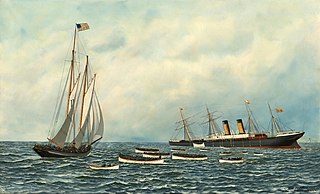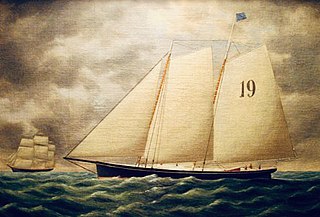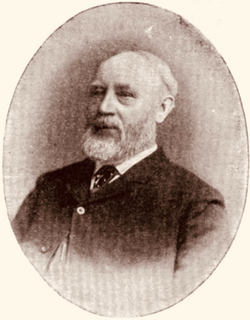
Joseph Henderson was a 19th-century American harbor pilot who guided large vessels into and out of New York Harbor as a Sandy Hook pilot. During his long career his work included bringing the ship that carried the Statue of Liberty safely into port after its trip from Europe, and was called upon as an expert seaman to determine the height of the water span of the Brooklyn Bridge, a new bridge from Brooklyn to New York City. On his death he was called "was one of the oldest and best known of the Sandy Hook [pilots]".

Romer Shoal Light is a sparkplug lighthouse in Lower New York Bay, on the north edge of the Swash Channel, about 3⁄4 nautical mile south of Ambrose Channel and 2+1⁄2 nautical miles north of Sandy Hook, New Jersey, in the entrance to New York Harbor. It is in New Jersey, very close to the border with New York.

The Isaac Webb was a 19th-century Sandy Hook pilot boat built in 1860 by Webb & Bell for the New York and Sandy Hook pilots. She received a reward by the Board of Pilot Commissioners of New York for saving three sailors from the wreck of the bark Sarah, that was caught up in a hurricane. The Webb was shipwrecked in a dense fog at Quonochontaug Beach, Long Island in 1879. She was replaced by pilot boat Columbia.

The Moses H. Grinnell was a 19th-century pilot boat built in 1850 for the New York maritime pilots. She was designed by the yacht designer George Steers. The Grinnell was the first pilot boat to feature a fully developed concave clipper-bow, which was to become the New York schooner-rigged pilot boat's trade mark. This new design was the basis for the celebrated yacht America.

The James Stafford was a 19th-century Sandy Hook pilot boat built in 1888 for the New York Pilots. She took the place of the pilot boat Enchantress, that was lost in the Great Blizzard of 1888. She was named after James Stafford, one of the oldest and prominent shipping men of Brooklyn. She sank near Sandy Hook in 1898 when she ran into the Dry Romer shoal. At that time, the Stafford was one of the oldest pilot-boats still in service in a time when they were being replaced with steam pilot boats.

The Phantom was a 19th-century Sandy Hook pilot boat built in 1867 from the designs by Dennison J. Lawlor. The schooner was considered a model for her type with a reputation for being very fast. She helped rescue the passengers on the steamship SS Oregon when it sank in 1886. She was one of the pilot-boats that was lost in the Great Blizzard of 1888. The Phantom was replaced by the pilot-boat William H. Bateman.

The Thomas S. Negus was a 19th-century two-masted Sandy Hook pilot boat, built by C. & R. Poillon shipyard in Brooklyn in 1873 for the New Jersey maritime pilots. She was built to replace the pilot boat Jane, No. 1, which sank in early 1873. She was the winner of a $1,000 prize at the Cape May Regatta in 1873. She was named for Thomas S. Negus, president of the N. J. Pilots' Commissioners. In 1897, she left the pilot service to prospect for gold during the Klondike Gold Rush.

Jacob A. Westervelt was a 19th-century Sandy Hook pilot boat designed by naval architect John W. Griffiths and built by Jacob A. Westervelt in 1853. She was one of the fastest pilot-boats in the fleet. In 1858, while attempting to board the British steamer Saxonia she was fatally run into and sank outside of Sandy Hook. The Edmund Blunt, was built to replace her.

The Washington was a 19th-century Sandy Hook pilot boat built in 1845 by C. & R. Poillon for New York Pilots. She was rebuilt several times, the last with the sail number "22" painted on her mainsail. In 1884, she was sunk by the German steamship Roma, and then replaced by a new Washington.

The Francis Perkins No. 13, was a 19th-century Sandy Hook pilot boat, built by Henry Steers in 1866 for a group of New York Pilots. She was considered one of the finest boats ever built. During a snow storm in 1887, the Perkins struck the steamship Aries and sank near the Barnegat shoals.

The John D. Jones was a 19th-century Sandy Hook pilot boat, built in 1859 at the Van Deusen shipyard in East River for a company of New York Sandy Hook pilots. She was one of the finest vessels of her class. She was replaced by the pilot-boat Widgeon, when the Jones sank in a collision with the steamer City of Washington in 1871.
The David Mitchell, was a 19th century Sandy Hook pilot boat built in 1846 at Baltimore, Maryland, for a group of New York Pilots. She was launched at the John A. Robb shipyard in East Baltimore. She was sold to the Pensacola, Florida pilot fleet in 1875.

The James M. Waterbury, was a 19th-century Sandy Hook pilot boat built in 1843, at Williamsburgh, Brooklyn for a group of New York Pilots. She helped on many of the rescues along the New York Harbor. One of last reports of the Waterbury, was in 1867 when seaman James Roach fell overboard and was drowned off Fire Island.

The Caprice, was a 19th-century Sandy Hook pilot boat built in 1871 by Brown & Lovell in East Boston, Massachusetts for Peter McEnany and other New York pilots. In 1876, she was run down and sank, off Bay Ridge, Brooklyn, by the steamship New Orleans. She was raised and was one of the pilot boats that survived the Great Blizzard of 1888. The Caprice was last reported sailing off the coast of New York in 1891.
Michael Murphy, was a 19th-century American New York Sandy Hook maritime pilot. He was best known for being in the Sandy Hook service for over 34 years. Murphy was captain and owner of the pilot boats, Washington,Abraham Leggett, and Alexander M. Lawrence. He piloted the Great Eastern from Southampton to New York in 1860.

The Mary E. Fish was a 19th-century Sandy Hook pilot boat, built at the Edward F. Williams shipyard of Greenpoint, Brooklyn in 1861 for Richard Brown and the New York Pilots. She was built to replace the Mary Taylor. The Fish was hit and sank by the schooner Frank Harrington in 1885 and replaced by the David Carll.

Josiah Johnson, Jr., was a 19th-century American New York Sandy Hook maritime pilot. He was best known for being in the New York Sandy Hook piloting service for over 47 years. He piloted over 5,000 vessels in and out of the New York Harbor without an accident. Johnson was captain and owner of the pilot boat Edmund Blunt.

The Coquette was a 19th-century yacht and pilot boat, built in 1845 by Louis Winde, at the Winde & Clinkard shipyard in Chelsea, Massachusetts for yachtsmen James A. Perkins. Her design was based on a model by shipbuilder Dennison J. Lawlor. The Coquette was a good example of an early American yacht with a clipper bow. As a yacht, she won the attention for outsailing the larger New York yacht Maria at the second New York Yacht Club regatta in 1846. Perkins sold the Coquette to the Boston Pilots' Association for pilot service in 1848. She continued as a pilot boat until 1867 when she was sold as a Blackbirder to be used on the African coast.
James Callahan was a 19th-century American New York Sandy Hook Pilot. He is well known for being one of the oldest Sandy Hook pilots, having served for 38 years. He was owner and operator of the William Bell that was captured and burned by the Confederate raiding steamer CSS Tallahassee during the American Civil War.

















